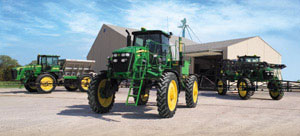Soil and weather conditions this spring in Iowa and surrounding states could have a major impact on development of the region’s corn crop going into the heart of the growing season, says an area agronomist. Crop stress associated with nitrogen deficiency should be a big concern for corn growers who experienced a cool, wet spring. That stress may start showing up soon in some fields.
According to Tracy Blackmer, an agronomist with the Iowa Soybean Association, the large amounts of rain and extended wet growing conditions this spring in some parts of Iowa and neighboring states resulted in higher than normal leaching and denitrification of earlier applied nitrogen fertilizers. In addition to wet weather, Blackmer adds that numerous other field and soil conditions, including crop residue levels, soil pH and type of nitrogen fertilizer used, can impact nitrogen availability and cause deficiency stress.
 “Nitrogen stress is critical to plant development from the eighth leaf stage to silking when the plant’s need for nitrogen is at its peak,” says Blackmer. He notes that similar wet weather in the spring of 2004 resulted in nearly 75 percent of tested fields in some areas of the state being nitrogen deficient during the growing season. This year could follow that same pattern.
“Nitrogen stress is critical to plant development from the eighth leaf stage to silking when the plant’s need for nitrogen is at its peak,” says Blackmer. He notes that similar wet weather in the spring of 2004 resulted in nearly 75 percent of tested fields in some areas of the state being nitrogen deficient during the growing season. This year could follow that same pattern.
Blackmer says remote sensing using aerial photography can be an effective tool to help detect nitrogen deficiency in plants early so that additional nutrients can be applied in a timely fashion.
Crop images provided by remote sensing services, such as the OptiGro™ system from John Deere Agri Services, make it even easier to detect even subtle changes in chlorophyll levels within the crop canopy, which correlate directly to nitrogen availability to the plants. “Remote sensing can be effective in detecting problems early, before it results in significant yield losses,” Blackmer adds.


 John Deere has just introduced a completely new line of sprayers – the 4730, 4830 and 4930 Series Self–Propelled Sprayers.
John Deere has just introduced a completely new line of sprayers – the 4730, 4830 and 4930 Series Self–Propelled Sprayers. 
 Duane Toews of
Duane Toews of 


 There is still a lot of discussion about the need for compatibility across agriculture equipment, be it a tractor, a sprayer, or a controller. True plug and play is possible in some instances, but has been slow to come. In a free market, that comes with the territory – companies put a lot of time and effort into developing specialized equipment, so there is always going to be the tendency to make things proprietary.
There is still a lot of discussion about the need for compatibility across agriculture equipment, be it a tractor, a sprayer, or a controller. True plug and play is possible in some instances, but has been slow to come. In a free market, that comes with the territory – companies put a lot of time and effort into developing specialized equipment, so there is always going to be the tendency to make things proprietary. 
 Linda Brekke of
Linda Brekke of 